人教版-七年级上册-英语知识点-全---第七单元-unit-7-知识点
- 格式:doc
- 大小:33.00 KB
- 文档页数:4
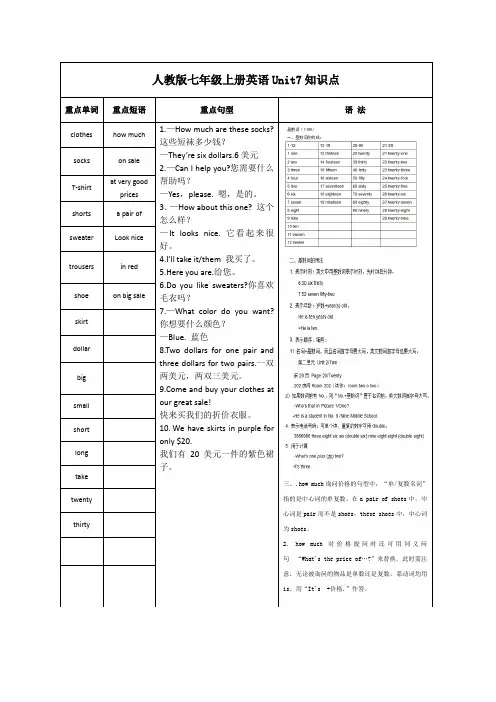
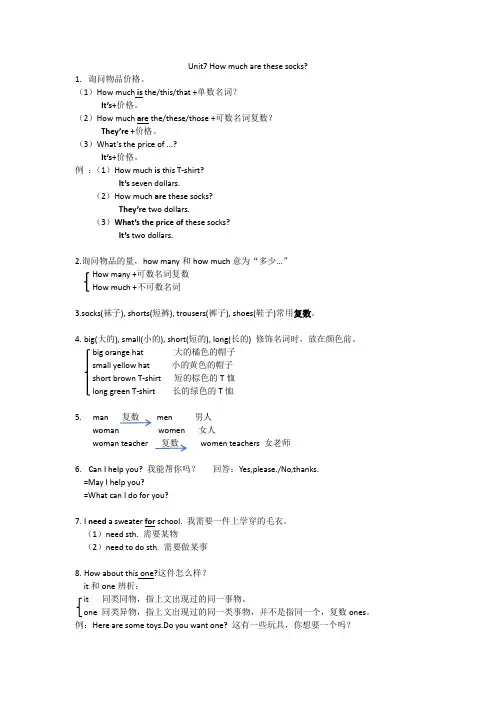
Unit7 How much are these socks?1.询问物品价格。
(1)How much is the/this/that +单数名词?It’s+价格。
(2)How much are the/these/those +可数名词复数?They’re +价格。
(3)What’s the price of ...?It’s+价格。
例:(1)How much is this T-shirt?It’s seven dollars.(2)How much are these socks?They’re two dollars.(3)What’s the price of these socks?It’s two dollars.2.询问物品的量,how many和how much意为“多少...”How many +可数名词复数How much +不可数名词3.socks(袜子), shorts(短裤), trousers(裤子), shoes(鞋子)常用复数。
4.big(大的), small(小的), short(短的), long(长的) 修饰名词时,放在颜色前。
big orange hat 大的橘色的帽子small yellow hat 小的黄色的帽子short brown T-shirt 短的棕色的T恤long green T-shirt 长的绿色的T恤5.man 复数men 男人woman women 女人woman teacher 复数women teachers 女老师6.Can I help you? 我能帮你吗?回答:Yes,please./No,thanks.=May I help you?=What can I do for you?7.I need a sweater for school. 我需要一件上学穿的毛衣。
(1)need sth. 需要某物(2)need to do sth. 需要做某事8.How about this one?这件怎么样?it和one辨析:it 同类同物,指上文出现过的同一事物。
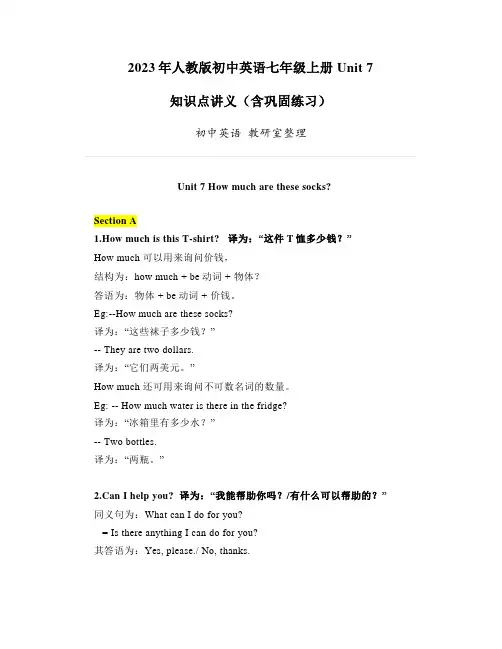
2023年人教版初中英语七年级上册Unit 7知识点讲义(含巩固练习)初中英语教研室整理Unit 7 How much are these socks?Section A1.How much is this T-shirt? 译为:“这件T恤多少钱?”How much 可以用来询问价钱,结构为:how much + be动词 + 物体?答语为:物体 + be动词 + 价钱。
Eg:--How much are these socks?译为:“这些袜子多少钱?”-- They are two dollars.译为:“它们两美元。
”How much 还可用来询问不可数名词的数量。
Eg: -- How much water is there in the fridge?译为:“冰箱里有多少水?”-- Two bottles.译为:“两瓶。
”2.Can I help you? 译为:“我能帮助你吗?/有什么可以帮助的?”同义句为:What can I do for you?= Is there anything I can do for you?其答语为:Yes, please./ No, thanks.3.need “需要”1)作情态动词时,无人称和数的变化,后面接动词原形。
Eg: She need go to school at once.译为:“她需要立刻去上学。
”2)作实义动词时,后面常接动词不定式或动名词。
常用结构为:need to do sth. “需要做某事”(表主动)Eg: She needs to go to school at once.译为:“她需要立刻去上学。
”Need doing sth. “需要做某事”(表被动)Eg: The tree needs watering.译为:“这棵树需要被浇水。
”4.介词for表示目的,它的含义是:“为...;去做...”Need... for... 表示“需要...去做...”Eg: I need some pens for my homework.译为:“我的作业需要一些钢笔。
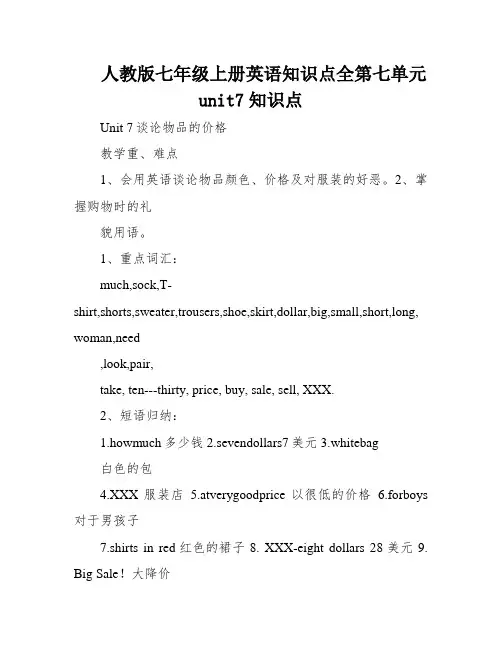
人教版七年级上册英语知识点全第七单元unit7知识点Unit 7谈论物品的价格教学重、难点1、会用英语谈论物品颜色、价格及对服装的好恶。
2、掌握购物时的礼貌用语。
1、重点词汇:much,sock,T-shirt,shorts,sweater,trousers,shoe,skirt,dollar,big,small,short,long, woman,need,look,pair,take, ten---thirty, price, buy, sale, sell, XXX.2、短语归纳:1.howmuch多少钱2.sevendollars7美元3.whitebag白色的包4.XXX服装店5.atverygoodprice以很低的价格6.forboys 对于男孩子7.shirts in red红色的裙子8. XXX-eight dollars 28美元9. Big Sale!大降价10.twenty yuan 20元11. a pair of black shoes一双黑色的鞋子3、Howmuch is this T-shirt?how much通常用来对价格进行提问,意为“多少钱”。
常构成句式“How much is/are+物品?”,回答用“It’s /They’re+价格”。
/直接用价格来回答。
——How much is your sweater?/——How much are these trousers?——It’s 123 dollars./123 dollars./——They’re130 yuan.】对价格进行询问时,还可用:What’s the price of…?使用这一句型时,无论被询问的商品是单数还是复数,be动词都用is,不能用are;其答语为It’s….价格是……——What’s the price of the book?——What’s the price of these books?——It’s five yuan .——It’s ten yuan .】辨析how much和how many透露表现“几何”,都是对名词的数目举行发问,二者区分以下:how muchhow many后接不可数名词,用于提问不可数名词的数量或代价后接可数名词复数,用于提问可数名词的数量句式:How much +不可数名词+一般疑问句?句式:How many +可数名词复数+普通疑问句?4、像socks, shoes, trousers, glasses, shorts,等都是成双成对的物品,一般以复数的形式出现。
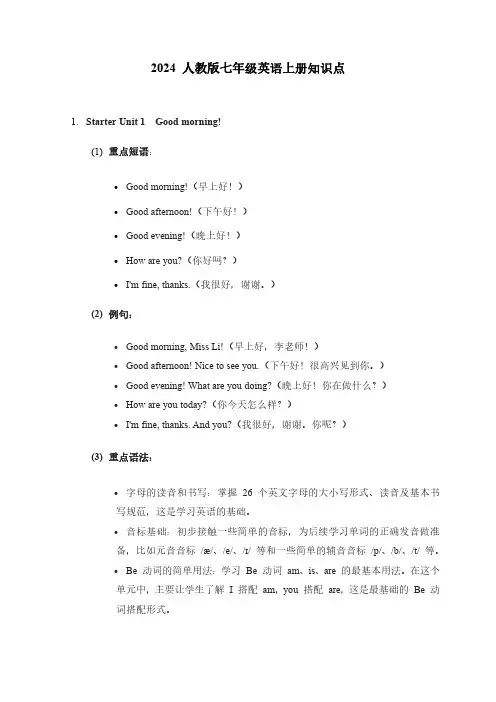
2024人教版七年级英语上册知识点1.Starter Unit1Good morning!(1)重点短语:∙Good morning!(早上好!)∙Good afternoon!(下午好!)∙Good evening!(晚上好!)∙How are you?(你好吗?)∙I'm fine,thanks.(我很好,谢谢。
)(2)例句:∙Good morning,Miss Li!(早上好,李老师!)∙Good afternoon!Nice to see you.(下午好!很高兴见到你。
)∙Good evening!What are you doing?(晚上好!你在做什么?)∙How are you today?(你今天怎么样?)∙I'm fine,thanks.And you?(我很好,谢谢。
你呢?)(3)重点语法:∙字母的读音和书写:掌握26个英文字母的大小写形式、读音及基本书写规范,这是学习英语的基础。
∙音标基础:初步接触一些简单的音标,为后续学习单词的正确发音做准备,比如元音音标/æ/、/e/、/ɪ/等和一些简单的辅音音标/p/、/b/、/t/等。
∙Be动词的简单用法:学习Be动词am、is、are的最基本用法。
在这个单元中,主要让学生了解I搭配am,you搭配are,这是最基础的Be动词搭配形式。
2.Starter Unit2What's this in English?:(1)重点单词:map(地图)cup(杯子)ruler(尺子)pen(钢笔)orange(橙子)jacket(夹克衫)key(钥匙)quilt(被子)what(什么)in(在……里)English(英语;英文)。
(2)重点短语:∙询问物品:What's this in English?(这个用英语怎么说?)、What's that inEnglish?(那个用英语怎么说?)∙回答方式:It's a/an...(它是一个……)。
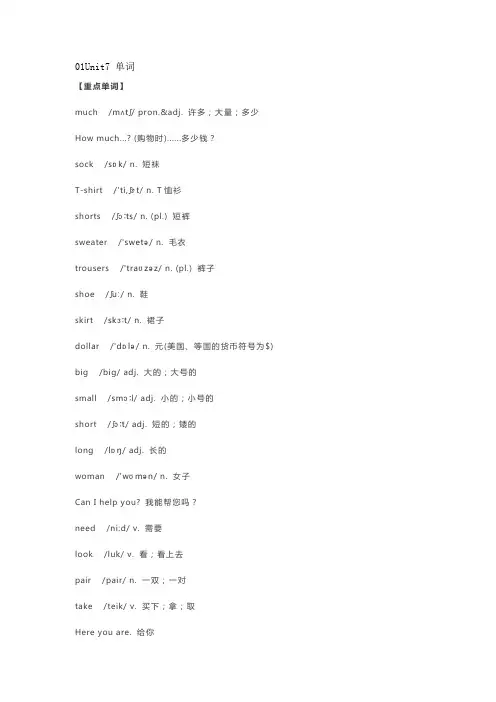
01Unit7 单词【重点单词】much /mʌtʃ/ pron.&adj. 许多;大量;多少How much...? (购物时)......多少钱?sock /sɒk/ n. 短袜T-shirt /'ti,ʃɝt/ n. T恤衫shorts /ʃɔːts/ n. (pl.) 短裤sweater /'swetə/ n. 毛衣trousers /'traʊzəz/ n. (pl.) 裤子shoe /ʃuː/ n. 鞋skirt /skɜːt/ n. 裙子dollar /'dɒlə/ n. 元(美国、等国的货币符号为$) big /big/ adj. 大的;大号的small /smɔːl/ adj. 小的;小号的short /ʃɔːt/ adj. 短的;矮的long /lɒŋ/ adj. 长的woman /'wʊmən/ n. 女子Can I help you? 我能帮您吗?need /ni:d/ v. 需要look /luk/ v. 看;看上去pair /pair/ n. 一双;一对take /teik/ v. 买下;拿;取Here you are. 给你ten /ten/ num. 十eleven /ɪ'lev(ə)n/ num. 十一twelve /twelv/ num. 十二thirteen /θɜː'tiːn/ num. 十三fifteen /fif'ti:n/ num. 十五eighteen /ei'ti:n/ num. 十八twenty /'twenti/ num. 二十thirty /'θɜːtɪ/ num. 三十Mr. /'mistə/ 先生clothes /kləʊ(ð)z/ n. (pl.) 衣服;服装store /stɔː/ n. 商店buy /bai/ v. 购买;买sale /seil/ n. 特价销售;出售sell /sel/ v. 出售;销售;卖all /ɔːl/ adj. 所有的;全部的very /'veri/ adv. 很;非常price /prais/ n. 价格boy /bɒɪ/ n. 男孩02Unit7 知识梳理Unit7 How much are these socks?【重点短语】1. these shorts 这些短裤2. what color 什么颜色3. a yellow sweater 一件黄色的毛衣4. twenty white skirts 20条白色的裙子5. a pair of brown trousers 一条棕色长裤6. thirte en pairs of sports shoes 13双运动鞋7. those long black pants 那些长的黑裤子8. seven dollars 7美元9. a short red T-shirt 一件短的红T恤10. a small black hat 一顶小的黑帽子11. at our great sale 在我们(店)大减价期间12. at a very good price/at very good prices 以非常优惠的价钱13. skirts in red 红颜色的裙子14. for boys/girls 对于男孩/女孩15. come to M r. Cool’s Clothes Store 来酷先生的服装店16. $ 2 for three pairs 三双2 美元17. buy sth. for sb. = buy sb. sth. 买某物给某人18. sell sth. to sb. / sell sb. sth. 把……卖给某人【重点句型】1.—How much is this T-shirt? 这件T 恤衫多少钱?—I t ’s seven dollars. 7 美元。
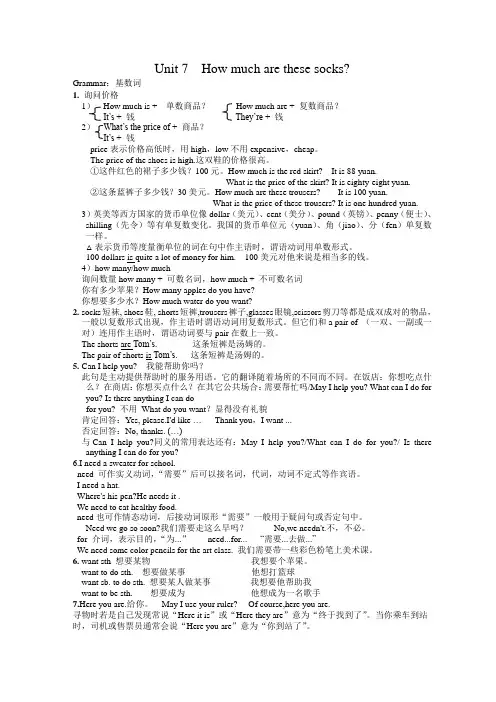
Unit 7 How much are these socks?Grammar:基数词1.询问价格1)How much is +单数商品?How much are + 复数商品?It’s + 钱They’re + 钱2)What’s the price of + 商品?It’s + 钱price表示价格高低时,用high,low不用expensive,cheap。
The price of the shoes is high.这双鞋的价格很高。
①这件红色的裙子多少钱?100元。
How much is the red skirt? It is 88 yuan.What is the price of the skirt? It is eighty-eight yuan.②这条蓝裤子多少钱?30美元。
How much are these trousers? It is 100 yuan.What is the price of these trousers? It is one hundred yuan. 3)英美等西方国家的货币单位像dollar(美元)、cent(美分)、pound(英镑)、penny(便士)、shilling(先令)等有单复数变化。
我国的货币单位元(yuan)、角(jiao)、分(fen)单复数一样。
△表示货币等度量衡单位的词在句中作主语时,谓语动词用单数形式。
100 dollars is quite a lot of money for him. 100美元对他来说是相当多的钱。
4)how many/how much询问数量how many + 可数名词,how much + 不可数名词你有多少苹果?How many apples do you have?你想要多少水?How much water do you want?2. socks短袜, shoes鞋, shorts短裤,trousers裤子,glasses眼镜,scissors剪刀等都是成双成对的物品,一般以复数形式出现,作主语时谓语动词用复数形式。
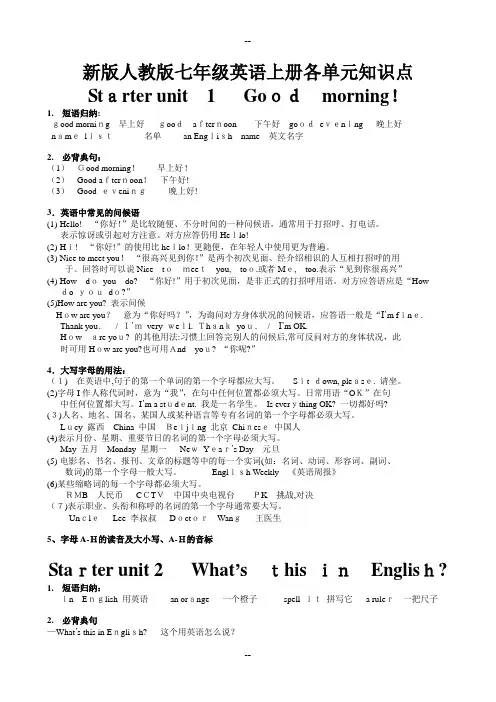
新版人教版七年级英语上册各单元知识点Starter unit 1 Goodmorning!1.短语归纳:good morning 早上好goodafternoon下午好goodevening 晚上好namelist名单an English name 英文名字2.必背典句:(1)Good morning!早上好!(2)Good afternoon!下午好!(3)Good evening晚上好!3.英语中常见的问候语(1)Hello!“你好!”是比较随便、不分时间的一种问候语,通常用于打招呼、打电话。
表示惊讶或引起对方注意。
对方应答仍用Hello!(2)Hi!“你好!”的使用比hello!更随便,在年轻人中使用更为普遍。
(3)Nice to meet you!“很高兴见到你!”是两个初次见面、经介绍相识的人互相打招呼的用于。
回答时可以说Nice tomeetyou,too.或者Me,too.表示“见到你很高兴”(4)How doyou do?“你好!”用于初次见面,是非正式的打招呼用语。
对方应答语应是“Howdo youdo?”(5)How are you? 表示问候How are you?意为“你好吗?”,为询问对方身体状况的问候语,应答语一般是“I’m fine.Thank you./ I’mvery well. Thankyou./I’m OK.Howare you? 的其他用法:习惯上回答完别人的问候后,常可反问对方的身体状况,此时可用How are you?也可用And you? “你呢?”4.大写字母的用法:(1)在英语中,句子的第一个单词的第一个字母都应大写。
Sit down, please. 请坐。
(2)字母I作人称代词时,意为“我”,在句中任何位置都必须大写。
日常用语“OK”在句中任何位置都大写。
I’m a student. 我是一名学生。
Is everything OK? 一切都好吗?(3)人名、地名、国名、某国人或某种语言等专有名词的第一个字母都必须大写。
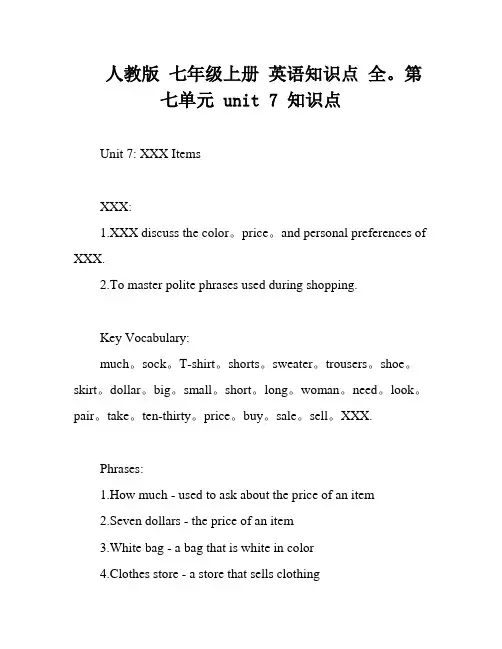
人教版七年级上册英语知识点全。
第七单元 unit 7 知识点Unit 7: XXX ItemsXXX:1.XXX discuss the color。
price。
and personal preferences of XXX.2.To master polite phrases used during shopping.Key Vocabulary:much。
sock。
T-shirt。
shorts。
sweater。
trousers。
shoe。
skirt。
dollar。
big。
small。
short。
long。
woman。
need。
look。
pair。
take。
ten-thirty。
price。
buy。
sale。
sell。
XXX.Phrases:1.How much - used to ask about the price of an item2.Seven dollars - the price of an item3.White bag - a bag that is white in color4.Clothes store - a store that sells clothing5.At very good price - at a low price6.For boys - for male children7.Shirts in red - shirts that are red in color8.XXX-eight dollars - the price of an item9.Big Sale。
- a sale with large discounts10.XXX yuan - the price of an item11.A pair of black shoes - two black shoesWhen asking about the price of an item。
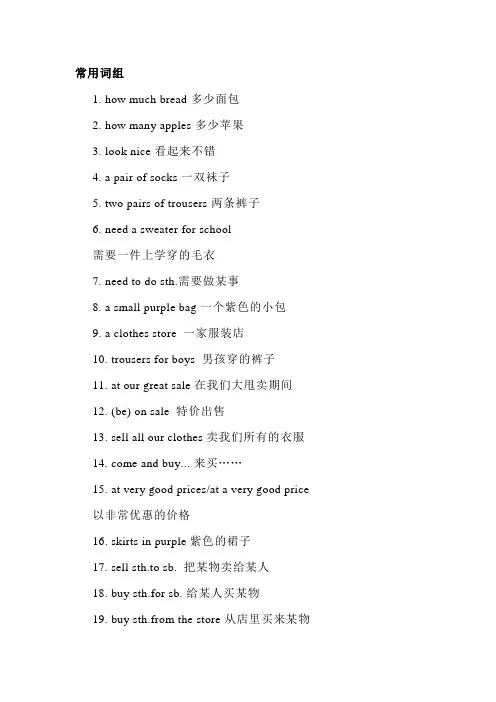
常用词组1. how much bread 多少面包2. how many apples 多少苹果3. look nice 看起来不错4. a pair of socks 一双袜子5. two pairs of trousers 两条裤子6. need a sweater for school需要一件上学穿的毛衣7. need to do sth.需要做某事8. a small purple bag 一个紫色的小包9. a clothes store 一家服装店10. trousers for boys 男孩穿的裤子11. at our great sale 在我们大甩卖期间12. (be) on sale 特价出售13. sell all our clothes 卖我们所有的衣服14. come and buy... 来买……15. at very good prices/at a very good price以非常优惠的价格16. skirts in purple 紫色的裙子17. sell sth.to sb. 把某物卖给某人18. buy sth.for sb. 给某人买某物19. buy sth.from the store 从店里买来某物我们在大甩卖,快来买衣服吧!10. What color do you want?你想要什么颜色的?11. What/How about this one/pair?这件/双怎么样?12. For boys, we have black trousers for only 22 dollars.对于男孩,我们有只要22美元的黑色长裤。
13. We sell all our clothes at very good prices.我们卖的所有服装价格都很优惠。
14. We have green sweaters for only $15!我们有只要15美元的绿色毛衣!15. Come to Mr.Cool's Clothes Store now!现在就来酷先生的服装店吧!词法精选1. buy 买buy sth.from sb.意为“向某人买某物”;buy sth.for+价格,意为“以……价格买某物”;buy sb.sth.=buy sth.for sb. 意为“给某人买某物”。
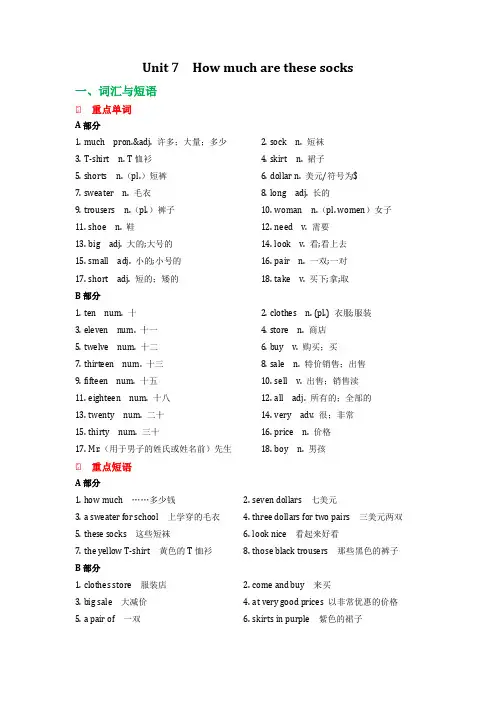
Unit 7 How much are these socks一、词汇与短语● 重点单词A部分1.much pron.&adj. 许多;大量;多少2.sock n. 短袜3.T-shirt n. T恤衫4.skirt n. 裙子5.shorts n.(pl.)短裤6.dollar n. 美元/符号为$7.sweater n. 毛衣8.long adj. 长的9.trousers n.(pl.)裤子10.woman n.(pl. women)女子11.shoe n. 鞋12.need v. 需要13.big adj. 大的;大号的14.look v. 看;看上去15.small adj. 小的;小号的16.pair n. 一双;一对17.short adj. 短的;矮的18.take v. 买下;拿;取B部分1.ten num. 十2.clothes n. (pl.) 衣服;服装3.eleven num. 十一4.store n. 商店5.twelve num. 十二6.buy v. 购买;买7.thirteen num. 十三8.sale n. 特价销售;出售9.fifteen num. 十五10.sell v. 出售;销售渎11.eighteen num. 十八12.all adj. 所有的;全部的13.twenty num. 二十14.very adv. 很;非常15.thirty num. 三十16.price n. 价格17.Mr.(用于男子的姓氏或姓名前)先生18.boy n. 男孩● 重点短语A部分1.how much ……多少钱2.seven dollars 七美元3.a sweater for school 上学穿的毛衣4.three dollars for two pairs 三美元两双5.these socks 这些短袜6.look nice 看起来好看7.the yellow T-shirt 黄色的T恤衫8.those black trousers 那些黑色的裤子B部分1.clothes store 服装店e and buy 来买3.big sale 大减价4.at very good prices 以非常优惠的价格5.a pair of 一双6.skirts in purple 紫色的裙子7.a clothes store 一家服装店8.at our great sale 在我们特价销售期间9.for girls 对于女孩子们● 重点句子A部分1.--How much are these socks? --Five dollars for three pairs.这些短袜多少钱? 五美元三双。
Unit 7 How much are these socks?一.重点单词:clothes, socks, T-shirt, shorts, sweater, trousers, shoes, skirt, dollar, big, small, short, long 二.短语归纳:how much 多少钱seven dollars 七美元white bag 白色的包clothes store 服装店at very good prices 以很低的价格for boys 对于男孩子skirts in red 红色的裙子twenty-eight dollars 28美元Big Sale! 大降价!twenty yuan 二十元a pair of black shoes 一双黑色的鞋子三.重点句型:—How much is/are …? ……多少钱?—It’s /They’re … 它/它们……I’ll take it. 我买了。
in+颜色某种颜色的衣服What color do you want? 你想要什么颜色的?buy sth from sb. 从某人那买某物sell sth to sb. 把某物卖给某人Here you are. 给你。
need doing sth需要被做need to do sth 需要做某事buy sb sth = buy sth for sb给某人买某物sell sb sth = sell sth to sb 卖某物给某人help sb with sth 帮助某人做某事help oneself (to) 自便,随便(吃/喝……)can’t help doing sth. 忍不住做某事四.典句必背:—How much is the hat? 这顶帽子多少钱?—It’s five dollars. 5美元。
—How much are these socks? 这双短袜多少钱?—They’re two dollars. 两美元。
人教版七年级上册Unit 7 How much are these socks?知识点归纳一、短语归纳1.how much 多少钱2.seven dollars 七美元3.seven yuan 七元4.Can I help you?需要帮助吗?5.need sth 需要某物6.need to do sth 需要做某事7.need sb to do sth 需要某人做某事8.a sweater for school 上学穿的毛衣9.I’ll take it.我买了10.two dollars for one pair 一双两美元11.here you are 给你12.clothes store 衣服店13.buy sth for sb为某人买某物14.buy sb sth给某人买某物15.great sale 大甩卖16.sell sth to sb 把某物卖给某人17.sell sb sth 卖给某人某物18.at very good prices以非常优惠的价格出售19.skirts in purple 紫色的裙子20. e to...来到...21. a pair of 一双,一副,一对22.help sb (to) do sth 帮助某人做某事23.help sb with sth 在某方面帮助某人二、重点句式1.—How much is this Tshirt ? 这件衣服多少钱?—It’s seven dollars. 7美元2.—How much are these socks?这双短袜多少钱?3.—Can I help you?你想买点什么?—Yes, please. I need a sweater for school. 是的,我想买一件毛衣上学穿。
4.What color do you want?你想要什么颜色?5.Two dollars for one pair and three dollars for two pairs.一双两美元,两双三美元。
人教版七年级初一英语上册复习各单元知识点归纳总结人教版七年级英语上册复习各单元知识点总结一、字母学习1.英语中共有26个字母。
其中的Aa,Ee,Ii,Oo,Uu5个字母被称为元音字母。
这五个元音字母是构成英语成千上万单词的核心,除了一些缩略词之外,其它任何一个英语单词,通常都应包含一个或多个元音字母。
26个字母中的其它21个字母被称为辅音字母。
2.字母书写的规格斜度:每个字母都要稍向右斜约10°左右,斜度要一致。
大写字母的书写规格是:上不顶天下立地。
即笔画的上端稍离第一线,笔画的下端必须紧贴第三线,不许离线也不许出格。
占中间格的小写字母有a,c,e,m,n,o,r,s,u,v,w,x,z13个,它们笔画的上端必须紧贴第二线,下端必须紧贴第三线,不许离线也不许出格。
占一格、二格的小写字母有b,d,h,k,l共5个,它们笔画的上端必须顶第一线,下端必须顶第三线,不许离线也不许出格。
小写字母i和t也占一格、二格。
但t的上端在第一格中间,短横重合第二线;i的小圆点在第一格中间稍偏下处。
占二格、三格的小写字母有g,q,y3个,它们的笔画的顶端要紧贴第二线,下端要紧贴第四线,不可离线也不可出格。
占一格、二格、三格的小写字母有f,j,p3个。
其中f的上端稍离第一线(和大写字母一样),下端紧贴第四线,短横重合第二线;j的小圆点与i的小圆点位置相同,下面一笔的上端顶第二线,下端紧贴第四线;p的上端略高于第二线,约占第一格的三分之一,下端紧贴第四线。
字母按所含音素归类表:/ei/字母:AaHhJjKk音标:[ei][eitʃ][dʒei][kei]/i:/字母:BbCcDdEeGgPpTtVv音标:[bi:][si:][di:][i:][dʒi:][pi:][ti:][vi:]/ai/字母:IiYy音标:[ai][wai]/əʊ/Oo/əʊ//ju:/字母:UuQqWw音标:/ju://kju://`dΛblju://ɑ:/Rr/ɑ://e/字母:FfLlMmNnSsXxZz音标:/ef//el//em//en//es//eks//zed/3.缩写词:HK香港ID身份PE体育课PRC中华人民共和国RMB人民币PLA中国人民解放军CCP中国共产党IOC国际奥林匹克委员会am上午pm下午cm厘米mm毫米4.英语句子的书写句子开头的第一个单词的第一个字母要大写,单词与单词之间要有适当的距离,一般为放入一个字母的空隙,句末要有标点符号,英语的句号是个实心圆点,而不是汉语中的小圆圈。
人教版英语七年级上册第七单元知识点Unit 7 How much are these socks?1.how much 的用法①对价格提问:How much +be(is/are)+主语(单数/复数)?某物多少钱?例如:1.—How much___(be)the sweater?—___8 dollars。
2。
-How much___(be)the shorts?—___12 dollars.②How much+be+主语?的同义句:—What’s the price of+主语?—It's 12 dollars。
例如:How much are the socks?=What’s the price of the socks?③How much还可以对不可数名词的数量提问:How much+不可数名词+其他?例如:How much milk do we need?我们需要多少牛奶?注:How many对可数名词的数量提问:How many+可数名词复数+其他?例如:How many bananas do we need?我们需要多少个香蕉?2.Can I help you?的同义句:What can I help you?Is there anything I can do for you?May I help you?3.need的用法:need+名词例如:I need a pen。
Need to do sth 例如:You need to finish the job on time.4.Look的用法:①可以单独使用,表动作。
Look!What is he doing?②短语:Look like看起来像。
He looks like his father.③看一看have a look at。
.. Let me have a look at the map。
have a look Please come and have a look。
Unit 7 How much are these socks?知识清单Section A重点单词I.much许多:大量;多少2. T-shirt T恤衫3.sweater毛衣4.shoe鞋5.sock短袜6.shorts短裤7.trousers裤子skirt裙子8.dollar元(美国、加拿大等国的货币单位,符号为$)big大的:大号的重点词组9.small小的;小号的10.short短的;矮的11. woman女子12.look看;看上去13.long长的14.need需要15.pair一双;一对16.take买下;拿;取l. how much... (购物时)……多少钱2.seven dollars 7美元3.a sweater for school一件上学穿的毛衣4.three dollars for two pairs三美元两双5.these socks这些袜子6.yellow T-s hirt黄色的T恤7.brown sweater棕色的毛衣black trousers黑色的裤子重点句型l.How much is this T-s hirt?这件T恤衫多少钱?2.It's seven dollars.7美元3.Can I help you?我能帮您吗?4.I need a sweater for school.我需要买一件毛衣上学穿5.How about this one?这件怎么样?6.I'II take it我买下了Section B重点单词l.ten +9.buy购买;买2.twelve十二10.sell出售;销售;卖3.eleven+-thirteen十三11.very很;非常4.eighteen十八12.store商店5.fifteen十五13.sale特价销售;出售6.twenty二+Mr.(用千男子的姓氏14. all所有的;全部的或姓名前)先生15.price价格7.thirty三十16.boy男孩儿8.clothes衣服;服装重点词组l.at a/one's great sale大促销2.clothes store服装店3. at very good prices以非常优惠的价格4.for boys对千男孩来说5.skirts in red红色的裙子6.big sale大降价7. twenty yuan 20兀8.a pair of一双9.black shoes黑色鞋子重点句型e and buy your clothes at our great sale!我们在大甩卖,快来买衣服吧!2.We sell all our clothes at very good prices我们卖的所有的服价格都很优惠3.For girls, we have skirts in purple for only $20对千女孩儿,我们有紫色的裙子,仅售20美元Section A知识点精讲1.How much is this T-shirt?这件T恤衫多少钱?how much此处用来询问物品的价格,意为“多少钱",相当千how much money。
Unit 7谈论物品的价格教学重、难点1、会用英语谈论物品颜色、价格及对服装的好恶。
2、掌握购物时的礼貌用语。
1、重点词汇:much,sock,T-shirt,shorts,sweater,trousers,shoe,skirt,dollar,big,small,short,long,woman,need ,look,pair,take, ten---thirty, price, buy, sale, sell, clothes.2、短语归纳:1.how much 多少钱2. seven dollars 7美元3. white bag白色的包4. clothes store 服装店5. at very good price 以很低的价格6. for boys 对于男孩子7. shirts in red 红色的裙子8. twenty-eight dollars 28美元9. Big Sale!大降价10.twenty yuan 20元11. a pair of black shoes 一双黑色的鞋子3、How much is this T-shirt?how much 通常用来对价格进行提问,意为“多少钱”。
常构成句式“How much is/are+物品?”,回答用“It’s /They’re+价格”。
/ 直接用价格来回答。
——How much is your sweater? / ——How much are these trousers?——It’s 123 dollars./123 dollars. / ——They’re 130 yuan.】对价格进行询问时,还可用:What’s the price of …?使用这一句型时,无论被询问的商品是单数还是复数,be动词都用is,不能用are;其答语为It’s….价格是……——What’s the price of the book? ——What’s the price of these books?——It’s five yuan . ——It’s ten yuan .】辨析how much和how many表示“多少”,都是对名词的数量进行提问,两者区别如下:how much 后接不可数名词,用于提问不可数名词的数量或价格句式:How much + 不可数名词+ 一般疑问句?how many 后接可数名词复数,用于提问可数名词的数量句式:How many + 可数名词复数+ 一般疑问句?4、像socks, shoes, trousers, glasses, shorts,等都是成双成对的物品,一般以复数的形式出现。
1)这类名词作主语时,谓语动词一般用复数形式。
e.g. How much are these shorts? / How much are these socks? 这双短袜多少钱?2) 若表示“一双,一副,一条”时则要用a pair of,但谓语动词用单数形式。
e.g. The pair of trousers is 98 yuan.a pair of / two pairs of socks/shorts (也可以用some, many, these, those等词修饰)5、dollar 可数名词,“美元”,其符号为$,其复数形式为dollars。
中国的货币单位是元,其符号为¥,为不可数名词。
1)表价格时,用单词则放在数字之后,用符号则放在数字之前。
e.g. 20 dollars =$20 .(货币符号没有复数形式)2)所有的钱数同时间、距离一样,无论多少,在句中作主语时,谓语动词都用单数形式。
e.g. 5,000 dollars is quite a lot of money for me.Five weeks is quite a long time.五周是相当长的一段时间。
6、——Can I help you? 我能帮您吗?====May I help you ? / What can I do for you? / Is there anything I can do for you?——Thank you,I want …/ Yes,please. I’d like… / No, thanks. I’m just looking around. / Just a look.这一句主要是英语国家里,服务员招呼客户的常用语,以表示客气和礼貌,而不说“What do you want?”。
——Can I help you?——______.I want to buy some T-shorts for my children.A.Yes, please.B. No, thanks.C. It doesn’t matterD. Ofcourse I can7、need “需要”1)当实义动词时,need + n. / prep. /to do sth. 】构成否定句和疑问句时需借助助动词do/does.e.g. I need a hat./ Does your mother need any help?2)当情态动词时,need + v原。
】变否定句时要在need 后加not,变疑问句时,要把need提到主语前。
e.g. You needn’t do it again. / Need he do his homework first?8、How about this one?one,代词,此处用于指代上文提到的sweaters中的一件。
e.g. I have some apples. Do you want one?】one 和it 均指上文出现过的名词,但其用法不同。
one 指代“同名异物”,即指代与前面事物同属一类的事物,并不是指同一个事物。
如果指代同类事物中的一些,要用onesit 指代“同名同物”,即指代上文出现过的同一事物e.g. This apple is small. Please give me this one. 这个苹果小,请给我一个大的。
These books are mine. Those ones are lily’s. 这些书是我的,那些(书)是莉莉的。
Where’s my pen ? I can’t find it.9、look 1)系动词,“看上去,看起来”,+ adj.e.g. You look very healthy. / The teacher looks very happy.2)作不及物动词,“看”,加宾语时要与at连用,即look at.e.g. Look! Here comes the bus. / Look at the picture, please.10、I’ll take it. 我买了。
此句是选好的商品并决定购买时的常用语。
如果选定的物品是单数时,说“I’ll take it.”;如果选定的物品是复数时,应说“I’ll take them.”。
1)I’ll = I will, will是助动词,表“将要”,用于表示将来发生的动作。
2)Take “买”,相当于buy/get/have。
在口语中,买东西常用take.e.g. The coat is very cheap. I’ll take it.11、Here you are.给你是把某物递给对方时的常说的一句话。
当你购物或借东西时,也常用这句,表示“给你”。
不同情景意义不尽相同。
当你乘车到站时,这句话意为“你到站了”。
当寻物时,若是自己发现的常说“Here it is.”或“Here they are.”,意为“找到了”。
——May I use your dictionary? Mine is at home.——___________________.A.Thanks a lot.B. I’d love toC. You’re welcomeD. Sure. Here youare.12、clothes n.“衣服”,统指(身上的)各种服装,包括上衣,裤子等。
1)它不能直接与数词连用,但可以用these, those,some等词来修饰。
2)clothes 本身是复数形式,作主语时,谓语动词总用复数形式。
但如果用量词suit 来修饰,谓语动词应和suit在单复数形式上保持一致。
e.g. This suit of clothes is Jim’s. / Those suits of clothes are on sale now.13、store 可数名词,“商店”,同义词为stop,store往往指百货商店。
还可做动词,“储存,储备“,e.g. You need to store food.14、buy 及物动词,“买”,反义词为sell(卖)buy sb. sth.===buy sth. for sb.给某人卖某物e.g. I want to buy my father some presents.====I want to buy some presents for my father.15、sell 及物动词,“出售,销售”,Sell sb. sth.===sell sth.to sb.卖某物给某人e.g. They will sell me their books.====They will sell their books to me .他们将要把他们的书卖给我。
16、sale n.“出售,销售”,其动词形式——selle.g. The sale of his old house will make him sad.at great sale 在大减价期间 e.g. Come and buy your clothes at our great sale.on sale (正在)出售,减价销售======at a sale e.g.The books are on sale。
for sale 待售,e.g. The house is for sale.on sale for 以…..价格出售 e.g. The hat is on sale for 8 dollars.17、.at very good prices 以很低(合理)的价格出售。
1)at ……以….的价格price n. “价格、价钱“与介词of 常构成短语:the price of…..“……..的价格”2)询问价格且句中有price时,疑问句通常用what ,不用how much;3)表示价格“高低”时,常用high和low,不用expensive 或cheap。
e.g. I buy it at a very good price,3 yuan .18、for only +具体价钱表示某物卖多少钱e.g. These trousers are for seventy yuan . / for only 28 dallars19、in + 颜色表“穿……颜色的……”e.g. The girl in red is my younger sister.那个穿红色的女孩是我的妹妹。